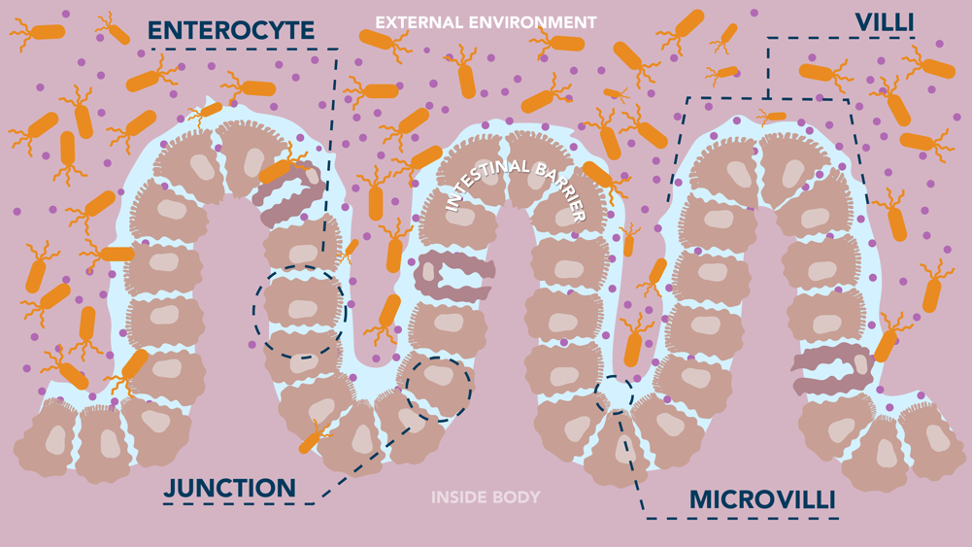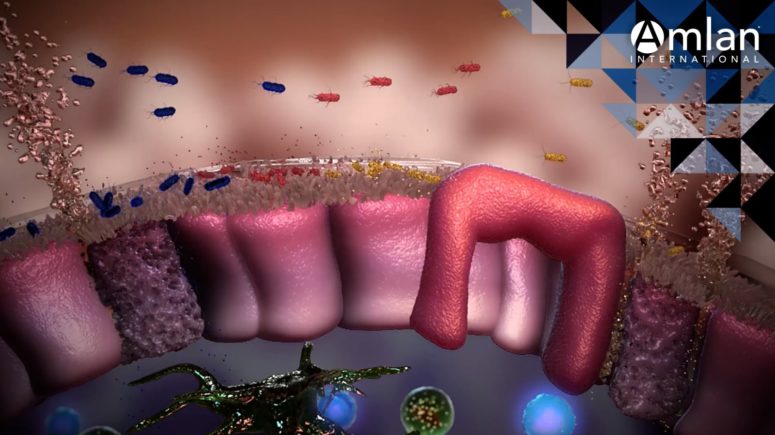A healthy, functional gastrointestinal tract that defends against pathogens and their toxins is essential for achieving peak performance in poultry and livestock. Intestinal diseases in protein production cause billions of dollars in economic loss each year, so finding effective methods to proactively protect the intestinal environment is an important task for producers, particularly for antibiotic-free (ABF) systems. Understanding how intestinal function affects the production efficiency and overall health of poultry and livestock is the first step in finding solutions to support a healthy intestinal environment. Watch our educational animated video here or read below to learn more.
Intestinal Function and Anatomy
The intestines are covered with finger-like structures called villi that increase the surface area of the intestine and whose primary function is nutrient absorption (Figure 1). The villi and the underlying tissue are also home to vast numbers of immune cells. Lining the villi are enterocytes: cells that use microvilli to absorb nutrients from the intestinal lumen into the circulatory system.
Between the enterocytes are tight junctions that regulate intestinal permeability. The enterocytes form the one-cell-thick intestinal wall which, together with a mucus covering, act as a barrier between the lumen contents and the rest of the body. To function correctly, the enterocytes need to be healthy, properly nourished and energized.

Defend Against Pathogen Invasion
The intestine does more than aid digestion and absorption; it acts as a gatekeeper, protecting the body against harmful pathogens and their toxins. The mucus and enterocytes that line the intestine form a barrier and are the first line of defense against the external environment. Therefore, if the intestinal environment is unhealthy and not functioning correctly, it can have a negative impact on multiple systems in the body.
In normal production settings, birds and livestock are exposed to pathogens through feed and the environment. Some pathogens are destroyed by the acidic environment of the stomach; however, some survive and establish within the microbiota of the small intestine. An imbalanced intestinal environment can result in an overgrowth of pathogens, which triggers the response that can lead to enteric disease (e.g., necrotic enteritis) or prevents animals from reaching their maximum production potential.
Once established, virulent strains of bacteria can secrete potent toxins during rapid cellular growth and metabolism. Lipid-like toxins can also be released from bacterial cell walls when bacteria die, either naturally, from antibiotic use or due to the immune response. The toxins disrupt the tight junctions and trigger enterocyte death, causing breakdown of the protective intestinal barrier (Figure 2). The barrier breakdown impedes nutrient digestion and adsorption, limits organ function and allows toxins to enter the circulatory system.

Natural Solutions to Maintain Intestinal Health
With the increase in antibiotic-free production systems, maintaining a healthy intestinal environment now requires a natural method to reduce the levels of pathogens in the intestinal environment. Amlan’s patented, natural mineral-based formulations, Varium® for poultry and NeoPrime® for swine, modify the intestinal environment by reducing pathogenic bacteria and their toxins, stimulating innate immune function and energizing enterocytes to create a strong intestinal barrier.
When Varium or NeoPrime are added to diets, pathogens and their toxins in the intestinal lumen are bound by Amlan’s proprietary, thermally activated mineral technology. The bound pathogens are then safely presented to the immune system via intestinal microfold (M) cells. Immune cells process these antigens and create more immune cells to naturally defend against invasion.
By presenting the bound antigens safely to the immune system before it is overwhelmed by high levels of pathogenic challenge, the immune system is thermally activated and prepared to mount a proper defense. After the pathogenic or toxin challenge is reduced, strengthening the epithelial cells that line the intestinal tract and keeping pathogens and toxins outside the body helps provide additional protection.
Maintaining a healthy intestinal environment is key to helping livestock and poultry perform to their maximum potential. Amlan can help, with next-generation mineral technology that reduces pathogenic challenges, strengthens the intestinal barrier and primes the immune system to naturally defend against disease. For more information, visit https://amlan.com/product/neoprime

